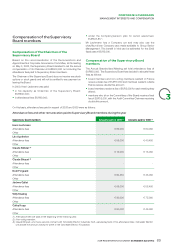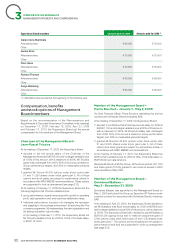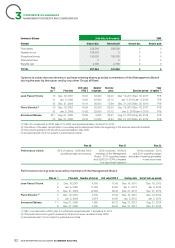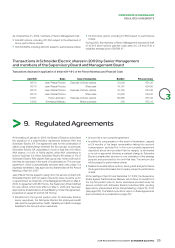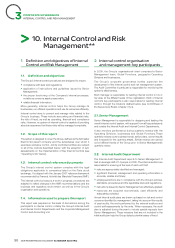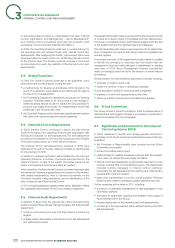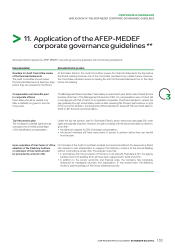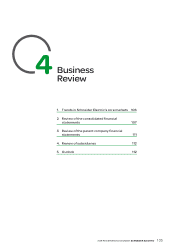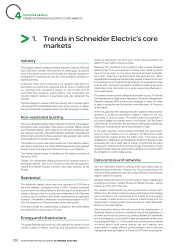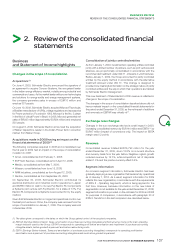APC 2009 Annual Report Download - page 100
Download and view the complete annual report
Please find page 100 of the 2009 APC annual report below. You can navigate through the pages in the report by either clicking on the pages listed below, or by using the keyword search tool below to find specific information within the annual report.
2009 REGISTRATION DOCUMENT SCHNEIDER ELECTRIC98
CORPORATE GOVERNANCE
3INTERNAL CONTROL AND RISK MANAGEMENT
An Innovation and Technology Committee meets monthly to ensure
cross-functional coordination among the Operating Divisions and
businesses for innovation and new products.
The Human Resources Department is responsible for deploying
and ensuring the application of procedures concerning employee
development, occupational health and work safety.
The Purchasing Department is responsible for establishing guidelines
concerning purchasing organisation and procedures; relationships
between buyers and vendors; and procedures governing product
quality, service levels, and compliance with environmental standards
and Group codes of conduct.
The Global Functions also issue, adapt and distribute policies, target
procedures and instructions to units and individuals assigned to
handle specifi c duties.
The Global Functions have internal control correspondents who work
with the Internal Control Department to establish and update the
Key Internal Controls deployed across the Group.They analyse the
results of self-assessments concerning the Key Internal Controls
that fall within their Function’s scope, identify internal control issues
that require action plans and either implement or oversee the
implementation of these plans.
3. Distributing information:
benchmarks and guidelines
The main internal control benchmarks are available to all employees,
notably on the Group intranet. The Global Functions send updates of
these reference documents to the appropriate units and individuals
through their networks of correspondents.
In some cases, dedicated e-mails are sent out or messages are
posted on the intranet portal to inform users about publications or
updates.
Whenever possible, the distribution network leverages the
managerial/functional organisation to distribute standards and
guidelines.
3.1. Principles of Responsibility
The Principles of Responsibility, initially published in 2002, were
updated in 2009. The Principles of Responsibility describe Schneider
Electric’s core values and each team member’s responsibility in
maintaining those values. They have been translated into all of the
languages used by the Group and are given to all new employees
along with their employment contract. Also available on the intranet,
the Principles of Responsibility are designed to guide employees in
their decisions and actions.
An Ethics Committee with correspondents has been set up to answer
employee questions that are not discussed in the companion guide
to the Principles of Responsibility (see Sustainable development,
framework, C hapter2 §2).
3.2. Insider Code
This code sets out the rules to be followed by management and
employees to prevent insider trading. It imposes an obligation of
confi dentiality on all employees who have access to price-sensitive
information and sets permanent restrictions on purchases and sales
of Schneider Electric shares by persons who have access to price-
sensitive information in the course of their work (see Organisation al
and operating procedures of the Supervisory Board C hapter,3§2).
3.3. International Internal Auditing Standards
The Schneider Electric internal auditors are committed to complying
with the international standards published by the Institute of Internal
Auditors (IIA ) and other bodies.
3.4. International Financial Reporting
Standards (IFRS)
The consolidated fi nancial statements for all fi scal years commencing
on and after January 1, 2005 have been prepared in accordance
with International Financial Reporting Standards (IFRS), to comply
with European Union regulation 1606/2002. The Group applies the
IFRS adopted by the European Union as of December 31, 2009.
The Group’s accounting principles refl ect the underlying assumptions
and qualitative characteristics identifi ed in the IFRS accounting
framework. This involves preparing the fi nancial statements on the
accrual basis of accounting and assuming that the business is a
going concern. Qualitative characteristics include understandability,
relevance, reliability and comparability. These characteristics rely on
information that is neutral, prudent and complete and that represents
transactions and events in accordance with their substance and
economic reality and not merely their legal form.
The management reporting and consolidation packages of all Group
entities are prepared strictly in accordance with Group accounting
principles and policies. IFRS guidelines are available on the intranet,
along with training modules covering the more technical aspects.
3.5. Commitment limits and authorizations
Commitment limits have been set for executives from Group level
down to the individual units. Under this system, contracts for the
purchase or sale of products or services exceeding EUR 10million
must be approved by the Chairman of the Management Board, while
those exceeding EUR 50million must be approved by the entire
Management Board.
In addition, all transactions that may affect the Group’s fundamental
interests, due to their size or nature, must be authorised in advance
by the Management Board or, in some cases, the Supervisory Board.
This rule applies in particular to all transactions affecting the scope of
consolidation, purchases and sales of strategic assets, trademarks
and patents, and off-balance sheet commitments.
3.6. Statutory and management reporting
principles
An integrated reporting and consolidation system applicable to all
Group companies and their management units has been in place
since January 1, 2006. Statutory and management reporting
principles and support tools are available on the Group intranet.
The subsidiaries record their transactions in accordance with Group
standards. Data are then adjusted, where necessary, to produce the
local statutory and tax accounts.
The reporting system includes consistency controls, a comparison
of the opening and closing balance sheets and items required to
analyse management results.



